50个专家仓库设计和布局思路和技巧
设计仓库布局看似简单,但实际上相当复杂。事实上,仓库的设计和布局会影响您的运营效率,影响拣货时间、工时,甚至会因交通不畅而增加安全风险。
我们收集了 50 个专家仓库设计和布局帮助您为您的设施设计理想布局以优化仓库生产力和提高安全性的想法、技巧和策略。点击下面的链接跳转到特定部分的提示:
- 仓库布局规划提示
- 设计仓库布局时的注意事项
- 仓库布局设计思路
仓库布局规划提示
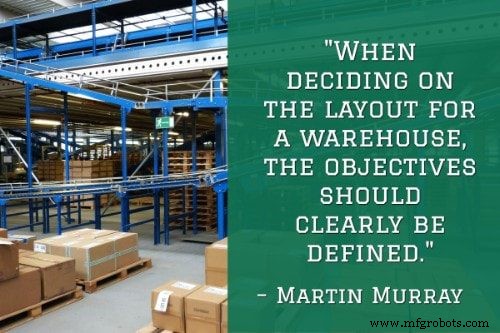
1.在开始规划过程之前定义您的目标。 “在决定仓库布局时,应明确定义目标。目标应与公司的整体仓储战略保持一致。可以在较高的层次上定义目标,例如降低仓储成本或提供最大程度的客户服务。
“同样,目标可以更具体,例如最大化仓储空间、提供最大的仓库灵活性或增加在不增加资源的情况下提高仓储效率。” – Martin Murray,规划和优化您的仓库布局 - 供应链影响 , 平衡小企业;推特:@thebalance
2.了解您当地的建筑规范。 “熟悉您当地有关仓库产品存储的建筑规范。例如,从托盘负载顶部到洒水喷头所需的最小间隙是多少?您的仓库是否位于需要特殊设计考虑的地震区?请注意任何安全注意事项,例如出口路径、叉车通道与人流量等。” – Kim Stebbins,仓库布局和设计:订购托盘货架前您需要了解的事项 , 下一级存储解决方案;推特:@NextLevelMHE
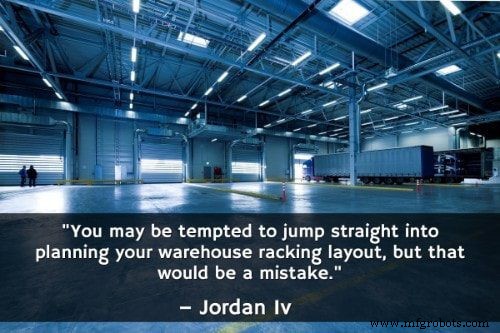
3.征求您的经理和承包商的意见。 “您可能很想直接开始规划您的仓库货架布局,但那将是一个错误。在您开始之前,请与知识渊博的承包商(如您的物料搬运公司)、您的仓库经理,甚至您的司机交谈:他们在仓库设施运营和规划方面拥有多年的经验,更不用说在您的特定仓库方面的经验了。解释您的目标和要求,然后听取他们的建议。” – Jordan Iv,如何设计仓库货架布局:高效规划的 10 个步骤 , 领英
4.挖掘仓库管理系统 (WMS) 中的历史数据。如果您没有 WMS,现在是进行投资的好时机。 “在当今竞争激烈的商业环境中,数据收集势在必行。当今的仓库管理系统 (WMS) 不仅可以跟踪库存,还可以收集关键的运营数据。通常,WMS 可以提出激进的建议,例如将您的产品上架理念从传统的基于产品价值的 ABC 分类转变为通常违反直觉但高效的方法,例如浮动库存仓库布局。
“我们建议实施避免下游错误的自动化资产跟踪数据收集方法——手动输入是不行的。更进一步,为资产分配唯一的跟踪编号,不要依赖序列号(通常不是唯一的)。不仅要跟踪可移动资产,还要跟踪您的固定资产。” – Cody Adams,终极仓库设计和布局的 13 个技巧 , 格式空间;推特:@RealFormaspace
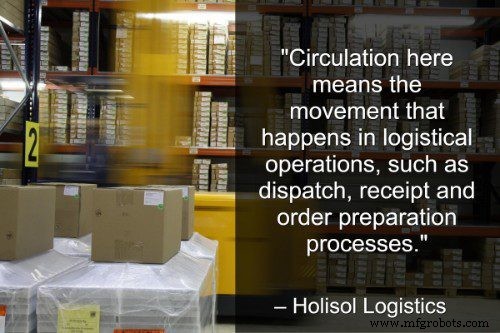
5.了解货物如何在您的设施中流通。 “这里的流通是指物流操作中发生的运动,例如发货、收货和订单准备过程。产品周转是商品更新的频率,即高周转产品是一种具有高投入和产出率的产品。移动负载涉及成本,因此如果公司操作程序允许,最好尽量减少移动。检测这些流量非常重要,因为它们有助于定义有效仓库设计所需的内容。” –完美仓库设计的 5 个因素 , 合力物流;推特:@HolisolLogistic
6.确定仓库各个区域之间的空间关系。 “一旦项目明确定义,该流程的第二阶段旨在制定一个总体规划来布局仓库区域。在这一步中,布局的非常具体的细节被故意忽略。但是,布局的其他方面需要仔细评估。
“启动此阶段最合乎逻辑的方法是确定仓库区域之间的空间关系。在绘制区域之间的关系时,需要考虑许多方面。夸大或低估任何一个因素的重要性和影响都可能对仓库的流动有害。我们的咨询团队使用逻辑评级系统来解决此问题。
“此阶段的下一步是确定每个区域所需的空间量。有几种方法可以完成此任务。在特定情况下,某些方法可能比其他方法效果更好。例如,在某些情况下,设施可能没有任何要布置区域的历史信息,而其他设施可能已经建立了空间标准。
“空间要求确定后,可以根据限制和条件进行调整。每个区域的具体需求。例如,某些区域可能需要出口门,而为其他区域提供更多过道空间可能是有意义的。” – Marvin Logan,如何创建更好的仓库布局 ,巴斯蒂安解决方案;推特:@BastianSolution
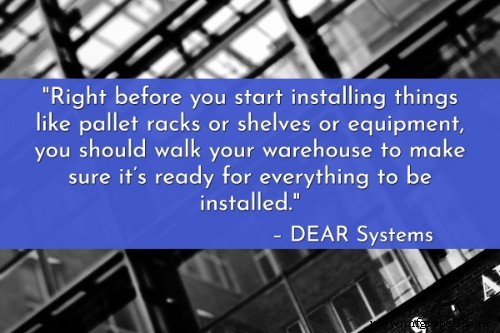
7.在开始安装新搁板和货架之前测试您的布局设计。 “在您开始安装托盘架、货架或设备之类的东西之前,您应该走动您的仓库,确保它已准备好安装所有东西。
“使用遮蔽胶带勾勒出主要工作区域的轮廓,并通过它搬运物品,滚动托盘搬运车,并让其他员工同时模拟工作。
“这将使您直观地了解您的空间,以及它是否经过优化。这里的任何错误都会在以后导致更严重的错误。” –关于如何有效规划仓库布局设计的 4 条提示 ,亲爱的系统;推特:@DearInventory
8.从原理图开始。 “一个好的仓库布局总是首先把它写在纸上,不管你的空间有多大。最简单的方法是使用仓库蓝图的副本,特别是如果您的空间很大或不是标准的矩形形状。如果你租房子,你的房东也许可以提供一个。
“如果你手头没有蓝图,在网格纸上画出你自己的仓库示意图很容易。我通常在原理图上使用 1 平方 =1 平方英尺。
“一旦您拥有按比例绘制的打印或在线原理图,请注意任何固定特征,例如柱子或支架、办公区扩建、安装的设备,顶门等,你必须解决。
“在我的仓库里,办公室的扩建占用了我必须计划的中间部分。我什至注意到办公室的门通向仓库,所以我们不会不小心挡住它。另外,作为运输操作,高架门位置是我的运输和接收工作流程的关键,因此我将它们用于这些用途。
“一旦您准备好原理图并注明主要特征,就该开始了规划您的空间。” – Krista Fabregas,规划您的仓库布局 – 如何设置高效的存储、包装和运输区域 , FitSmallBusiness.com;推特:@FitSmallBiz
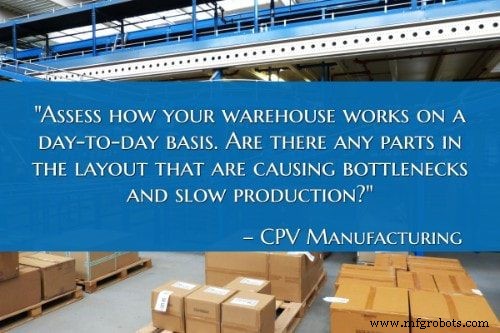
9.创建流程图。 “评估您的仓库的日常运作情况。布局中是否有任何部分导致瓶颈和生产缓慢?如果是这样,您需要优化仓库的布局,以确保顺畅高效的工作流程。
“制作流程图,详细说明您的设施当前的运行方式以及每个区域的位置。然后选择需要更改的区域。
“接下来,创建一个新的流程图,其中包含所做的布局更改。例如,如果您注意到生产和包装的瓶颈,新的工艺图可能会移动包装区,以便轻松满足生产需求。” –如何设计具有成本效益的仓库:优化您的仓库布局设计 , CPV 制造;推特:@cpvmfg
10.除了您的流程,您还需要深入了解您的库存。 “除了了解您的工作流程外,还需要了解将存储在那里的库存。为此,您需要了解这些物品的尺寸和形状、运输这些物品所需的物料搬运设备以及您将要存储的每件物品的总量。这很重要,原因有很多。
“首先,物品的大小很重要,因为这些物品占用的空间越多,您用于其他库存物品的空间就越少,无论是相同物品还是否则。这很重要,因为当您经营仓库时,每平方英尺对您来说都是要花钱的。此外,检查移动每个物料搬运设备所需的材料将对库存存储之间所需的车道宽度产生影响。显然,需要叉车或其他重型机械的物品将需要更宽的车道。但是,您还需要考虑该地区的整体人流量,以确保您设施中员工的整体安全。” –仓库规划指南:利用空间 , Panel Built, Incorporated;推特:@PanelBuilt
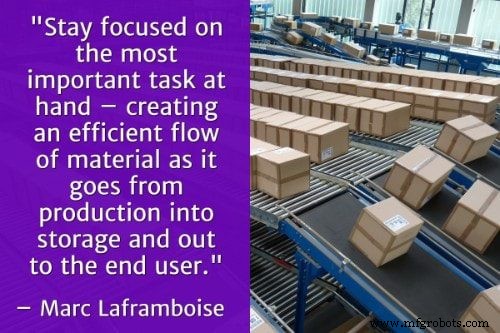
11.不要只是暂时设计仓库布局。您还应该创建其他设计以适应未来的预计增长。 “我在创建仓库布局设计方面的经验从过度拥挤的现有空间到寻找方向的完全空荡荡的建筑物。我对两者的初步建议是将您的想法和概念写在纸上。
“当然,对仓库布局进行非常清晰的 AutoCAD 3D 设计看起来很棒,但重要的是从基础开始并在铅笔到纸上。专注于手头最重要的任务——在从生产到存储再到最终用户的过程中创建高效的物料流。
“使用正确的设备、存储介质和充足的空间——但这一切都归结为它设计得如何能够承受您的快速增长。尝试预测未来的增长,并为现在创建一个设计,以及为未来设计一些其他设计。” – Marc Laframboise,仓库布局设计 , 材料处理程序;推特:@MaterialH4ndler
12.不要忽视充足的照明。 “仓库照明不佳会导致工人花费不必要的时间来寻找如果制定了适当的照明计划就会很容易看到的物品。除了工人生产力低下之外,由于潜在危险的可见性差,包括过道交通和绊倒危险,照明不足也会导致安全问题。存放带有小标签的物品的位置比存放带有大标签的物品的区域需要更多的照明。” – Justin Johnson,制造仓库布局的最佳实践 , 计时;推特:@HoustonChron
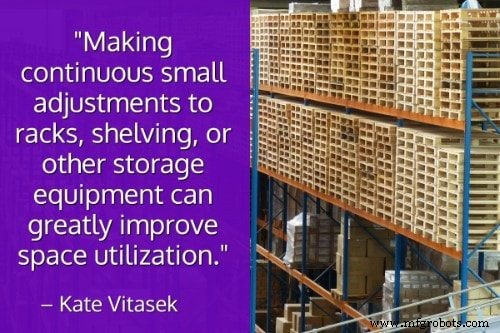
13.定期检查您的仓库布局和流程,找出效率低下的地方。 “大多数公司在仓库的初步布局上都下了很大功夫;然而,行业调查会告诉你,多达一半的公司没有一个持续的流程来审查他们的布局。审查存储区域的配置方式并制定流程以在产品组合发生变化时重新配置存储区域被认为是最佳实践,并且对于保持高水平的空间利用率和效率至关重要。对货架、货架或其他存储设备进行持续的小幅调整可以大大提高空间利用率。
“所有仓储软件都基于数据运行,因此产品和存储位置数据必须保持最新和准确。最佳实践公司将所有信息保存在单一记录系统中,并保持最新和准确。产品数据应包括所有产品特性,包括立方体数据、批次/序列号信息和特殊要求,以便将产品定向到特殊存储区域。 Special storage areas may be used to segregate items with odor transfer or fire risk or that require temperature control. High-value product might require caged or controlled-access storage.” – Kate Vitasek, Storage and Inventory Control Best Practices , Multi-Channel Merchant;推特:@mcmerchant
14. If you’re redesigning an existing warehouse layout, determine what changes must be made immediately and what changes will require more time to implement. “Once you have decided to initiate changes, identify what changes should be initiated immediately and completed within three to six months and which changes require longer to implement and complete. It’s equally important to determine which action items are capital-intensive. These may be either necessary or secondary but will be required in the long term.” – Warehouse Assessment to Identify Ways to Increase Facility Capacity , F. Curtis Barry &Company; Twitter:@FCurtisBarryCo
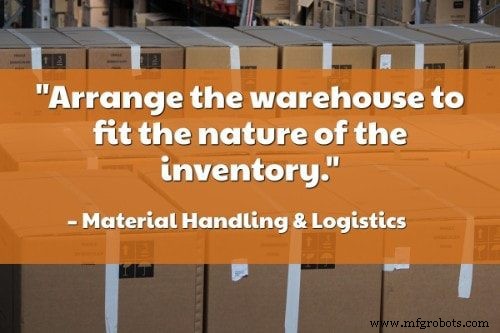
15. A simple spreadsheet analysis can provide insight into how many rows of various depths and how many racks are needed. “Arrange the warehouse to fit the nature of the inventory. If it will store large quantities of few SKUs, many deep rows are needed. If the inventory will be small quantities of many SKUs, mostly shallow rows with many faces is more practical.
“A simple spreadsheet analysis calculates how many rows of varying depths and how many racks are needed. From this it calculates the area needed for storage and aisles. Space for docks, offices and future expansion are not included.
“The analysis is based on a ‘snapshot’ of current inventories, modified to include future changes. Although individual SKUs may vary from week to week, the mix of deep and shallow rows is surprisingly stable and one period can be very representative. The height pallets can be stacked depends on the weight of the product, strength of the packaging, building height, etc.” – Planning a Warehouse , Material Handling &Logistics
16. Plan for adequate dock and receiving space based on the number of SKUs (and types of products) your facility handles. “After we have found an appropriate location, or if you’re retrofitting an existing facility, we go straight to the design phase, and we assess operational data to gain insight into your facility’s goals. Using this data, we analyze daily production and receiving cycles. We also use the data to account for changing inventory levels throughout the day. This information helps us create a layout that speeds processes and creates flow through the workspace. By knowing where products are coming from, where they’re being stored, and how often they’re moving through the facility, we can create a design that uses space wisely.
“One of the main components in layout design is optimizing the ability to accommodate various types of pallet loads. Some warehouses handle single pallets with one SKU, which is easy to receive and easy to store. Other warehouses, however, handle loads of chemical materials and other substances, which need to be quarantined and tested before storing. Whether you’re handling pallet loads with one SKU or 1000, we design a receiving area that can support operations. We make sure you have ample dock and receiving space.” – Layout Design , Warehouse1; Twitter:@warehouse1
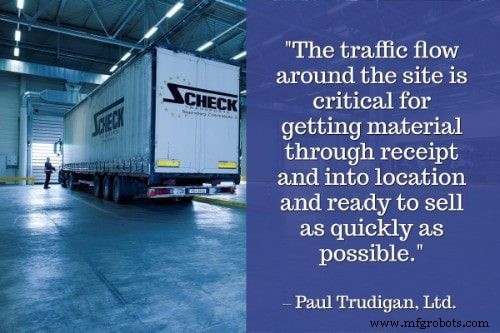
17. Perform a slotting analysis. “Now that you have separated your inventory by product category, velocity, and unit of measure, the next stage is to perform a slotting analysis to balance your inventory. Slotting is the process where you define the quantity and size of all your forward pick and reserve locations. This is determined by analyzing the best combination of product category, velocity, and unit of measure to place in forward pick locations, and where to store the reserve inventory for each product category by velocity. It is important to have dimensions and cubic volume for every product in each unit of measure you inventory. Balancing inventory with picking and replenishment is critical when determining the size of your pick faces. To decide how large your pick faces should be, analyze the cube, velocity, and the number of times you want to replenish each product group and velocity combination.” – Victor Coronado, Optimizing the Warehouse to Maximize Space and Efficacy , LinkedIn
18. It’s a good idea to draw several layouts (including internal and external layouts) and validate them before making a final decision. “Once the previous decisions have been phased out, a critical part in the design process starts that is the preparation of possible layouts. However, it is important to make differences between the internal and external layout. On one hand, the external layout will show where the warehouse area is going to be located and the relevant roadways and parking areas. One important decision is to determine the traffic around the warehouse area. On the other hand, the internal layout includes the different areas in which it is going to be divided, the dock area location and number of docks needed. This will include the classification between the areas with fewer distances for the greatest flows. The internal layout should meet the following objectives:
- Throughput efficiency
- Building utilization
- Safety
- Environmental aspects
“After drawing the possible layouts, they should be validated. This validation should be made according an operational and a technical feasibility point of view, checking that the layouts meets the requirements proposed in the first step of the framework. Finally, the preferred layout should be chosen. For that, all the possible layouts are going to be put together and different conclusions are going to be drawn, both quantitative (e.g., financial costs) and qualitative (e.g., SWOT analysis). After all this it is possible to choose the design that best meet the company activity and expectative.” – Beatriz del Río Tomé, Material flow design in a warehouse: The case of S:t Eriks , Lund University; Twitter:@lunduniversity
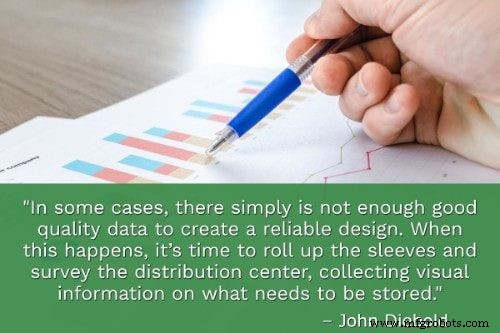
19. Not enough data? Conduct a survey. “In some cases, there simply is not enough good quality data to create a reliable design. When this happens, it’s time to roll up the sleeves and survey the distribution center, collecting visual information on what needs to be stored. There are generally four methods which can be used to gather this information:
- Method #1:Product cube:Use a database of product dimensions.
- Method #2:Survey storage cube:Survey each item in each bin in the distribution center. Record the SKU number and capture some information as to the amount of space occupied by that SKU in the distribution center.
- Method #3:Utilize bin cube (bin-by-bin):Measure the dimensions of each bin, and capture the rough percentage of space in each bin which is occupied by product. This is not a SKU-specific method.
- Method #4:Utilize bin cube (aggregate):Measure the dimensions of each bin, and determine a general utilization factor that applies to each bin type. This is not a SKU-specific method.” – John Diebold, Planning a Warehouse Layout with Imperfect Data , Commonwealth Supply Chain Advisors
Considerations When Designing a Warehouse Layout
20。 A new (more efficient) layout can have a direct impact on ROI. “ROI (return on investment) is a key factor in considering changing a warehouse layout or doing a full facility redesign. Congested aisles can cause lost time and efficiency. Inefficiencies can cause stock-outs in prime pick locations, which impairs operations, and costs money. Money may also be wasted by renting additional off-site warehouse space. Resolving these factors can contribute to reducing operating costs and improving the bottom line, not to mention reducing damage to the building, racking or forklifts.” – A Guide To Warehouse Optimization Using Expert Warehouse Consultants , Arbor Material Handling; Twitter:@AMH_inc

21. Traffic flow is a key consideration in any warehouse layout design. “This may sound like an obvious focus for warehouse design, but it is regularly overlooked, or compromised in favor of maximizing a building’s square footage. The traffic flow around the site is critical for getting material through receipt and into location and ready to sell as quickly as possible. Go to any industrial estate in the UK and you will see trucks parked up on the public highway waiting to be able to access sites for unloading. This waiting time costs businesses money in both demurrage and the potential for delayed orders and lost sales. You must ensure that the exterior layout and traffic flow is sufficient to receive, offload and despatch goods in the quickest turnaround times possible.
“Efficient traffic flow starts with incorporating the right number of bays into the warehouse layout and the right configuration of bays. Depending on the type of operation, there should be a mix of level access bays and dock level bays. For example, in an e-commerce operation material may come in on curtain sided trailers that need to be unloaded from the side and enter the warehouse through a level access bay. However, for despatch, orders may be despatched onto rigid vehicles requiring rear-loading and consequently dock level bays.” – Warehouse Design – 5 Tips for Success , Paul Trudigan, Ltd.; Twitter:@paul_trudigan
22. Design with safety and ergonomics in mind. “Ensuring that your warehouse is safe not only means less accidents and increased costs to you as a business; it also helps your operation to run more smoothly and efficiently.
“In our previous blog post about warehouse safety we discussed how by designing your warehouse to minimize the amount your staff have to bend, reach and twist can help them work better, without the risk of injury. Ensuring that your inventory does not need to be moved more than once can also help.” – 4 ways to improve your warehouse layout design , Kerridge; Twitter:@KerridgeCS
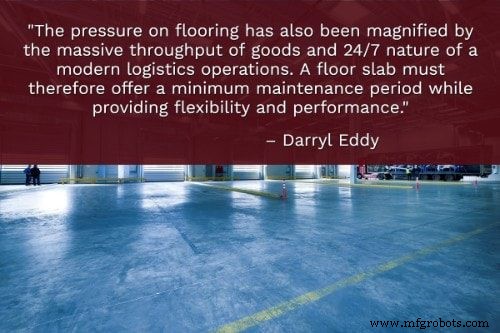
23. Flooring is actually a consideration that can have substantial impacts on a warehouse operation. “The emphasis on warehouse flooring has undeniably increased due to modern building techniques. The quality and durability of a floor slab can affect, for good or bad, all elements of the process in a warehouse. ‘With many warehouse and logistics operators now taking full advantage of new technology that often requires bigger and taller buildings, the demand for a flatter floor is significantly higher,’ exemplifies Darryl Eddy, director of Twintec Industrial Flooring.
“The pressure on flooring has also been magnified by the massive throughput of goods and 24/7 nature of a modern logistics operations. A floor slab must therefore offer a minimum maintenance period while providing flexibility and performance.
“‘Traditional ground-bearing floor slab construction uses concrete nominally reinforced with fairly light mesh and then incorporates saw-cuts to induce shrinkage cracks to a pre-planned grid,’ says Eddy. ‘Floors with such joints are prone to curl, and are very bumpy for forklifts, eventually leading to breakdown and ongoing maintenance for both floor and machines.’
“In order to design and build a floor for a warehouse, it is necessary to understand the properties of the floor constituent materials. By examining concrete mix, fibre type and fibre dosage, a warehouse operator can evaluate which floor will best match the demands of the warehouse in question. ‘Steel Fibre Reinforced Concrete (SFRC) is a composite material and can be used to produce reinforced floors that do not require joints, therefore reducing maintenance of forklift and floor,’ says Eddy.” – Darryl Eddy, as quoted by Middle East Logistics Staff, Top 10 tips for warehouse design , Middle East Logistics; Twitter:@Logistics_ME
24. Address non-productive aisles. “Sometimes, wasted space starts with the warehouse layout. What once was an efficient design now could be a storage nightmare.
“Contrary to what some may think, your warehouse layout should actually be very flexible. That way, it can easily accommodate your business as it changes over time—from expanding product to storing new, different-sized items.
“That being said, take a look at your design—or hire a professional to analyze it for you. Your aisles may be too wide or you could be basing the design around your rack system or lift equipment instead of the building.
“After thoroughly assessing your layout (and going over your options like installing a mezzanine or modular inplant office, etc.) can you decide whether non-productive aisles really are the problem or perhaps you really have run out of space and need to upgrade to a larger facility.” – 9 Warehouse Solutions to Maximize Non-Productive Aisles Without Breaking the Bank , Specialized Storage Solutions
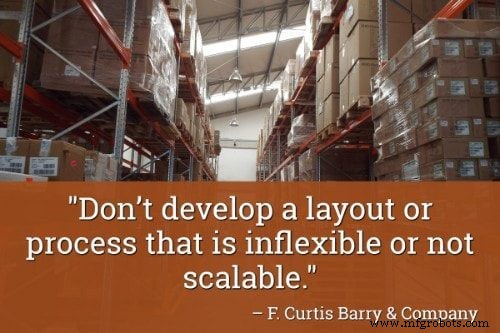
25. Your warehouse layout design should be both flexible and scalable. “Planning for unknown future changes to the business or fulfillment model is a necessity to avoid unnecessary costs to make unplanned changes to the facility and operation. Don’t develop a layout or process that is inflexible or not scalable. Read about how to develop an effective warehouse layout process here.” – Warehouse Layout Design Principles , F. Curtis Barry &Company; Twitter:@FCurtisBarryCo
26. Activity levels and storage requirements are two important factors that can be used to determine the ideal warehouse layout. “There are as many ways to design a warehouse as there are facilities. Based on the specific needs of your organization, your space may dramatically differ from a warehouse serving the same industry. Whether you’re moving into a new space or updating your current layout, one of the most important pieces of information you can communicate is the overall activity level and storage requirement of your operation:
- Low activity/low storage requirements – Often seen in smaller operations where manual handling is the norm.
- High activity/low storage requirements – Characterized by a single forward picking area with minimal storage overflow.
- Low activity/high storage requirements – Frequently a manual or semi-manual picking procedure that necessitates multi-level, high-density storage.
- High activity/high storage requirements – Typical of large-scale distribution centers, these fast-paced facilities rely heavily on automated material handling systems and extensive storage capacity.
“Heating, cooling, and humidity controls can also have significant bearing on the warehouse design. Some require more general accouterments like storage, sufficient aisle space, designated receiving and shipping areas, etc. Others must protect perishables with proper chill space, refrigeration requirements and humidity control equipment.” – A Guide to Getting the Most out of a Warehouse Design Service , RackExpress; Twitter:@rackexpress
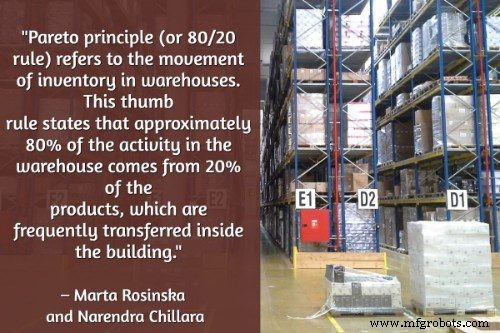
27. The Pareto Principle is applicable to the movement of inventory in warehouses. “Different warehouses use various storage methods and different types of racks or mezzanines. The combination of different types of storage systems is extremely important in maximizing the usable space. The storage equipment storage be selected based on the movement of livestock (Ten Hompel et al., 2007).
“Pareto principle (or 80/20 rule) refers to the movement of inventory in warehouses. This thumb rule states that approximately 80% of the activity in the warehouse comes from 20% of the products, which are frequently transferred inside the building. Next 15% of the activity is derived from the 30%stock keeping units (SKUs), which mobility rate is defined as the average. Finally, 5% of the activity comes from 50% of the inventory, which are stored in a slow manner. By separating the fast, medium and slow-moving products within the plant and increasing access to products requiring the highest activity, the throughput can be increased significantly.
“Moreover, by facilitating access to these products, additional time can be gained to transfer the products inside the building (Ackerman, 2013).
“Parts with high turnover are usually stored in warehouses with high volumes using pallet racking with standard width passes. Companies that have a reach truck can store products with a high turnover in places where there are narrow aisles. Products with an average circulation are more suitable for storage in narrow aisles. Lastly, it is suggested to store slow-moving products in a very narrow aisle by trucks with rising cabin. However, this is only theory that aim to support the decision how to store goods. Depending on the situation and needs, the scenario might be different (Ten Hompel et al., 2007).” – Marta Rosinska and Narendra Chillara, Layout design planning of a logistics center: A study on space utilization after merger of two warehouses , Department of Technology Management and Economics, Division of Supply and Operations Management, Chalmers University of Technology; Twitter:@chalmersnyheter
28. Unique inbound shipment characteristics can play a role in optimal warehouse design. “Inbound shipment characteristics also play a large role in warehouse design. The ideal inbound shipment? A full palletload from a pre-certified vendor, with a single SKU ready for immediate putaway.
“At the other end of the spectrum, chemical or pharmaceutical materials may require lab testing before they can be accepted for putaway into inventory. This means product must be quarantined in a separate receiving area while it awaits testing.” – Lisa Harrington, Designing the Perfect Warehouse , Inbound Logistics; Twitter:@ILMagazine
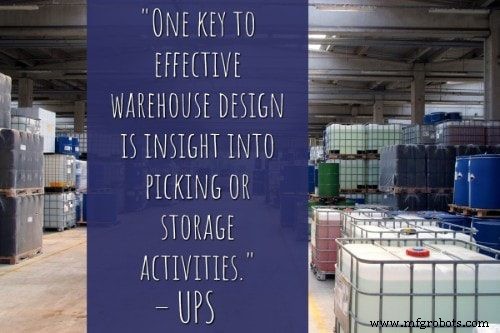
29. Don’t over-complicate picking processes by overemphasizing storage needs. Instead, your goal is to find the perfect balance between the two. “Because warehouses are a buffer for inbound shipments from suppliers and outbound orders to customers, the nature of warehousing often changes from storage to transaction. In addition, overseas sourcing increases the need for warehousing–increasing its importance in the supply chain.
“One key to effective warehouse design is insight into picking or storage activities. A large warehouse space can meet storage needs but complicate picking processes. You need to find a balance for the design of your warehouse.” – Warehouse Design and Layout , UPS; Twitter:@UPS
30. Allow ample space for goods-in. “The goods receiving area of your warehouse is generally a hive of activity, which all too often is crammed into an inadequate space for the purpose.
“While it may seem counterintuitive to give up floor and racking space to expand the goods-in section of your warehouse, releasing a larger floor area here can often lead to greater overall warehouse layout efficiency—and therefore reduced operating costs.” – Rob O’Byrne, 4 Ways to Improve Warehouse Layout Efficiency and Save Costs , Logistics Bureau; Twitter:@LogisticsBureau
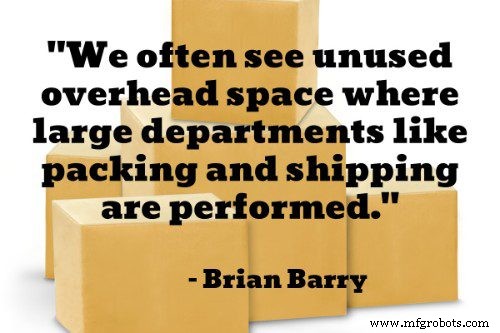
31. Analyze department space to tap into unused overhead space. “Identify functions that do not require high ceilings in areas where lower stacking heights are dictated by the clear height. We often see unused overhead space where large departments like packing and shipping are performed.
“Look up and make sure you’re using all the vertical space available. Investigate storage media to take advantage of your clear span height. How much cubic feet of vertical space is not being used? Be sure to know how your design might impact your sprinkler design and fire code.” – Brian Barry, 15 Ways to Improve Warehouse Space Utilization , Multi-Channel Merchant;推特:@mcmerchant
32. Give forklift operators as wide a path as possible. “Space is also key in maintaining an efficient environment for forklift operation. That doesn’t simply refer to the square footage of the warehouse. It’s possible to have a very large facility with little operable space. The idea here is to provide as a wide of a path as possible for your forklift operators. One easy way to do this is to keep all stored products and packages up against a wall. If your inventory and/or space limitations require the construction of aisles, then make sure you have plenty of space between rows for a forklifts to maneuver without being cramped. The width between aisles will largely depend on the type of forklifts you are using as models vary in terms of turning radius, elevation and reach. Once you’ve identified the forklift models in your warehouse, construct your aisles accordingly. This will not only speed up work flow, it will also go a long way in avoiding accidents..
“Width between aisles isn’t the only important consideration in the layout of your aisles. Logical and proper labeling is also key. As much as possible, try to stack items of a similar kind or category in the same aisle, and make sure each aisle is clearly labeled so employees know which items can be found there. This will avoid hours of confusion and backtracking that can result when employees are not sure where to find specific inventory items. Creating short cuts through aisles can also help to streamline storing and delivery. Putting gaps in the middle of aisles will allow employees to make a direct a path to the items they need without having to walk or drive forklifts around entire aisles to get there.” – Tom Reddon, Best Practices for an Efficient Warehouse Layout , National Forklift Exchange; Twitter:@TomReddon
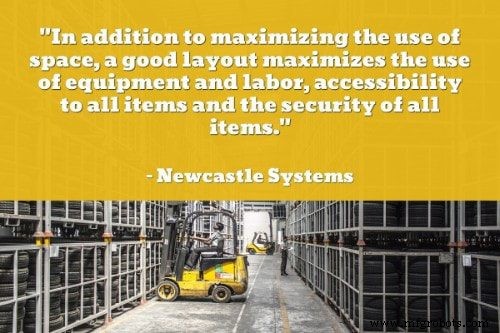
33. An optimized warehouse layout not only maximizes the use of horizontal and vertical space, but also equipment and labor. “The optimal layout factors both the floor space and the vertical space available for use. In addition to maximizing the use of space, a good layout maximizes the use of equipment and labor, accessibility to all items and the security of all items. Using forklifts that reach the roof of the warehouse allows for a configuration that maximizes both the horizontal and vertical space.
“The complementary solution is to ensure that the highest-selling inventory is easily accessible by placing it at the most accessible point.” – Top Five Warehouse Management Problems and How to Fix Them , Newcastle Systems; Twitter:@NewcastleSys
34. Review global layout efficiency. “It’s always been like this and to complicate to change. This is the common comments. Start looking at the global warehouse configuration and think of those 3 basic points:space utilization, productivity and global operation control &management. Look at opportunity to change considering those points:aisle orientation, product flow, incoming and outgoing operation, location of services area (employee access, building services, working area (repack etc)), fix equipment location (stretch wrap, scale, packing tables, etc). Look at measuring productivity per sector or operation and evaluate time consumption and finally review your WMS performance.” – Albert Goodhue, Warehouse Layout Optimization:Some basics steps , GCL Logistics &Supply Chain Consulting
Warehouse Layout Design Ideas
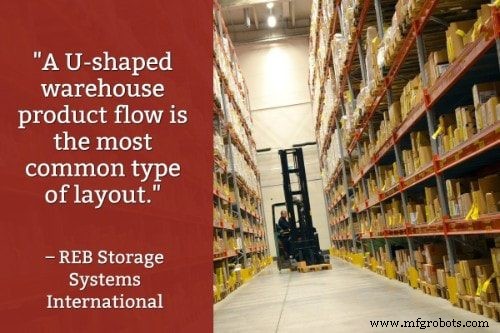
35. A U-shaped product flow is the most common type of warehouse layout, but that doesn’t mean it’s the best layout for your business. “A U-shaped warehouse product flow is the most common type of layout. In this layout the shipping and receiving docks are located next to one another, offering shared utilization of dock resources such as personnel and material handling equipment. This layout also minimizes product handling, offering high cross-docking capability.” – Warehouse Layout &Product Flow Options , REB Storage Systems International; Twitter:@REB_Storage
36. If you need enhanced security, an I-shaped or L-shaped warehouse layout may be better suited to your needs. “I-shaped warehouse product flow and L-shaped warehouse product flow, also known as through flow, are similar in that the shipping and receiving areas are located on different sides of the warehouse. As a result, these require more available warehouse space than U-shaped layouts.
“These layouts can be beneficial for certain operations. For example, warehouses that require heightened security can benefit from the separate ‘in’ and ‘out’ areas. I-shaped and L-shaped layouts can also provide larger sorting and storage areas for both shipping and receiving docks as well as allowing for isolated monitoring of each function.” – Warehouse Layout &Product Flow Options , REB Storage Systems International; Twitter:@REB_Storage
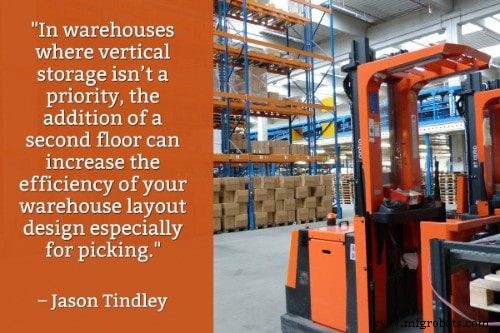
37. Consider adding a floor. “In warehouses where vertical storage isn’t a priority, the addition of a second floor can increase the efficiency of your warehouse layout design especially for picking. Mezzanine floors offer a way to maximize warehouse space without the high costs of complete renovation. These types of floors are ideal for small warehouses looking to expand their space due to increased product demand.” – Jason Tindley, How To Design An Efficient Warehouse Layout In 10 Easy Steps , Logistics Planning Consultants; Twitter:@LPCINT
38. Incorporate cross aisles. “If all of the aisles in your warehouse are long and continuous, it could make getting from one place to another extremely difficult. Increase efficiency by creating a grid of cross aisles.” – 6 Smart Tips on How to Improve Your Warehouse Layout Design , Porta Power, Inc.; Twitter:@PortaPowerInc
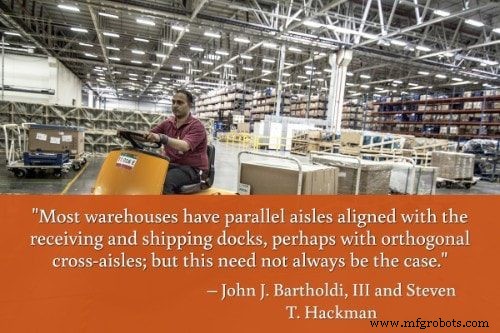
39. A fishbone layout, featuring angled aisles, is touted by some experts. “Most warehouses have parallel aisles aligned with the receiving and shipping docks, perhaps with orthogonal cross-aisles; but this need not always be the case. Kevin Gue of Auburn University and Russ Meller of the University of Arkansas [23] have argued that travel times can be reduced by up to 20% by reorienting some aisles and including some angled cross-aisles, which they call a fishbone layout. The overall warehouse must be slightly larger to compensate for the space lost to the additional aisles; but this is more than made up for by the efficiency of more direct travel to or from a centralized point of receiving and shipping.
“It is possible to take advantage of this more direct travel if most pallet movement is to or from the central dispatch point. But if a forklift finishes putting away a pallet and then must retrieve another, the orientation of the aisles of the fishbone arrangement may not help at all, and indeed may be an impediment. Nevertheless, this possibly inefficiency seems to be more than made up for by the direct travel to and from the central dispatch point.” – John J. Bartholdi, III and Steven T. Hackman, Warehouse &Distribution Science , Release 0.94, The Supply Chain and Logistics Institute, School of Industrial and Systems Engineering, Georgia Institute of Technology (Latest version, Release 0.98, can be downloaded from Warehouse-Science.com)
40. Ensure that processes are positioned closely to other processes and functions they rely on. “The overall layout of the warehouse is an important factor in the optimization of operations. The flow throughout should generally move in either a line or a ‘U’ shape. In this facility there is a single door for both incoming shipments and outgoing orders, so the flow should be in a circular manner. Beginning with reception from the manufacturer, to putaway and replenishment, to order picking and fulfillment, and finally concluding with packaging and delivery to the outgoing shipper, each process should be in close proximity to those it relies upon.” – Tobiah R. Master, Warehouse Redesign of a Facility Layout, Racking System, and Item Classification at Sunrize Tackle, Inc. , California Polytechnic State University; Twitter:@CalPoly
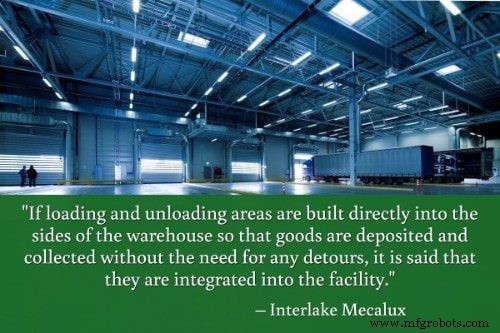
41. If space is available, integrated loading and unloading areas can offer greater load handling speed. “If loading and unloading areas are built directly into the sides of the warehouse so that goods are deposited and collected without the need for any detours, it is said that they are integrated into the facility. The main advantage of this is the greater load handling speed, which means it is preferable to non-integrated options if there is sufficient space for it.
“Trucks are connected to the warehouse via the docks and these docks can be:
- Docks separated by an intermediate platform: They are appropriate when this separation is advisable as determined by the nature of the goods or the need to maintain the internal warehouse environment or when there are safety issues relating to the material stored. A typical example of applying this type of separated dock is for cold chambers, where cold loss could occur if a flush dock is used with an access door and where this must be avoided at all costs. Yet there are many other circumstances in which this design is preferable, particularly when the safety of the warehouse could be compromised.
- Flush docks: They allow trucks to back right up to the warehouse wall. To avoid affecting the internal environment of the facility, access doors must have, as a minimum, a hermetically sealed system. This seal can be metal or created through the use of a dock shelter.” – Warehouse layout design , Interlake Mecalux; Twitter:@IKMXus
42。 Design a variety of location sizes to accommodate a greater variety of storage needs and take advantage of all available space. “We see instances where one or two cases stored in a location designed for a full pallet. It is necessary to have a variety of location sizes to accommodate the variety of storage needs on a product by product basis. Another waste of space occurs in picking areas where only the front portion of the pick slot is utilized with empty space left behind. The slotting process should take care of this, but we see it a lot in many warehouses. Make sure the pick slot is designed to fit the cubic velocity of the SKU. It is impossible to attain 100% of capacity on a daily basis but the higher % you can maintain in established locations, the more space you will have available.” – Warehouse Layout and Design Ideas to Begin Improving DC Capacity , F. Curtis Barry &Company; Twitter:@FCurtisBarryCo
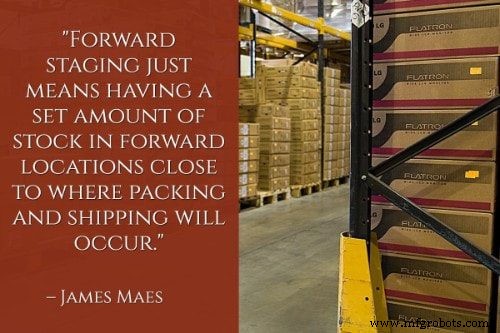
43. Incorporate forward locations to streamline picking efficiency. “Another way to optimize picking is by using forward locations. Forward locations can be a huge time saver, especially with more popular or high-volume items. The idea is to minimize trips to more remote locations in the warehouse at the same time that you minimize the distance a picker has to travel to get an item.
“Forward staging just means having a set amount of stock in forward locations close to where packing and shipping will occur. When an order for one of these items comes in, an employee can choose items from the forward location quickly. As the quantities in the forward location get low, replenishment stock from elsewhere in the warehouse (or from a less expensive off-site location) can then be brought forward.” – James Maes, 8 Tragically Common Mistakes in Warehouse Setup , Infoplus Commerce; Twitter:@infopluscommerc
44. Rethink your rack and shelving solution, and expand vertically. “Rather than expand the footprint of your warehouse, consider better use of vertical space. Adding taller storage units and the right equipment to pick and store material can help you keep more in the same square footage, rather than adding expansion costs. In addition, think about the type and variety of shelving used. Storing small items on pallet racks wastes space, and makes it easy to misplace items. Rather than using the same racks throughout your warehouse, you may need various types of shelving for different materials. Also, try using standardized bins to help keep shelves neat and orderly.” – Danny Hammack, Five simple ways to improve warehouse efficiency , CIPS; Twitter:@supplymgmt
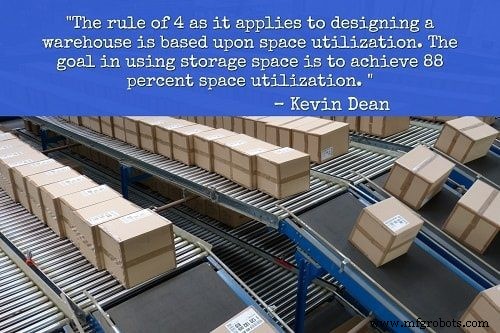
45。 Use the Rule of 4 and aim for 88 percent space utilization. “The rule of 4 as it applies to designing a warehouse is based upon space utilization. The goal in using storage space is to achieve 88 percent space utilization. The reason for this is that a higher utilization requires too many aisles to achieve the storage slot space utilization, and therefore is wasteful. A lower utilization causes the warehouse to have honeycombing, which is the phenomenon of a warehouse that has pallet locations filled with half empty pallets – the locations are full and locked up, but the actual storage space contains more air than product.” – Kevin Dean, How to design a space-efficient and productive new warehouse , Raymond Handling; Twitter:@RaymondHandling
46. Other experts suggest that operations run best at about 85% full. A facility under 85% full reduces potential profit. “Inventory is a huge factor in determining an optimized layout for your warehouse. The type of inventory you distribute, the amount, and the length of time the product is in the warehouse are all things that should be taken into consideration during the planning process. Things like the inbound and outbound process as well as the way the items are stored should also be considered. Aside from the type of inventory, you should also consider how much you are going to keep available at your warehouse at any time. Operations run best at about 85% full, anything more than that will be less efficient and anything less would reduce your potential profit. Projected order statistics along with past data can help determine an optimized solution.” – Optimize Your Warehouse Layout , Supply Chain Link; Twitter:@NFIindustries
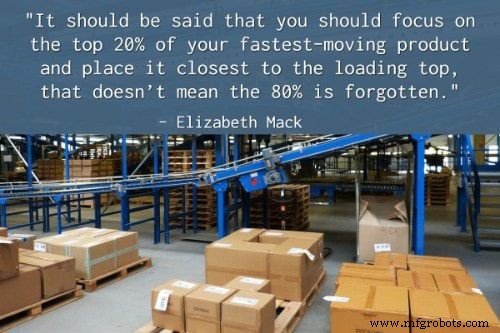
47. Use high-density shelving to organize slow-moving inventory. “It should be said that you should focus on the top 20% of your fastest-moving product and place it closest to the loading top, that doesn’t mean the 80% is forgotten. This is where high-density shelving systems come into play.
“In particular, high-density shelving systems are great for storing slow-moving product. Often times, businesses are so focused on their fast-moving product that slower-moving product is put on the wayside.
“What this type of shelving system does is double your storage capacity and make it easy and efficient for employees to retrieve inventory. Its accessibility and space-saving features are the reasons why we added it to the list.” – Elizabeth Mack, Warehouse Solutions You May Need to Make Your Facility More Efficient , Specialized Storage Solutions
48. Incorporate the four functional warehouse zones in your layout. “The top 4 functional warehouse zones identified using forecasting and projections are storage, yard/dock, picking and VAS/kitting zones. To identify the proper size of the storage area evaluate key factors such as project inventory levels, temperature requirements, product dimensions, fulfillment rules, flow through rates and more. All of these factors will play a part in determining proper storage layout. Data must also be collected to determine yard and dock door requirements. Too little staging space and dock doors can create a significant bottleneck, slowing down warehouse productivity. When determining picking and shipping size and location identifying your picking strategy will help to make these decisions. Consider the space requirements needed for all types and which will work best for your available resources.” – Cold Storage Warehouse Best Practices:Warehouse Layout Optimization , Datex; Twitter:@Datexcorp
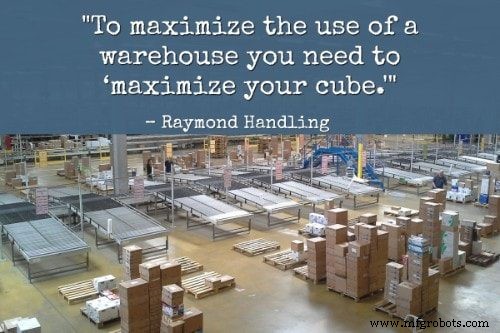
49. Maximize your cube. “To maximize the use of a warehouse you need to ‘maximize your cube.’ You need to take advantage of all of the vertical space that you have available. With a conventional fire protection system you can stack products up to 18” below the fire sprinkler heads. In an ESFR (Early Suppression, Fast Response) system this distance is 36”. You may need to reconfigure your existing storage system to take advantage of this space but it could be worth the effort.” –
How to optimize your existing warehouse space , Raymond Handling; Twitter:@RaymondHandling
50. Keep special processing areas under control. “Create space-saving layouts for special processing areas such VAS and returns. According to Elenbark [Bill Elenbark, senior engineer for the supply chain consulting firm TranSystems], special processing areas have a tendency to creep in size and spread out over larger areas than are required. It may be high time to take a closer look and consider making space-saving changes. If a lot of pallets are sitting on the floor, consider adding a short section of pallet rack to take advantage of cube. Carousels can be used as buffers to accumulate processed returns before returning them to inventory.” – Maida Napolitano, Space Optimization:Mission Impossible? ,物流管理;推特:@LogisticsMgmt
Products and Tracking Solutions from Camcode:
- Rack Location Labels
- Barcode Stickers
- Barcode Warehouse Labels
- UID 标签
- Inventory Labels
- 过道标志
- Equipment ID Tags
- Custom Warehouse Signs
- 铝箔标签
工业技术


